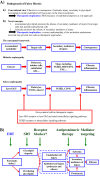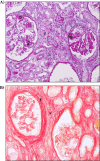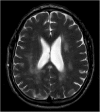Fibrosis: a key feature of Fabry disease with potential therapeutic implications
- PMID: 23915644
- PMCID: PMC3750297
- DOI: 10.1186/1750-1172-8-116
Fibrosis: a key feature of Fabry disease with potential therapeutic implications
Abstract
Fabry disease is a rare X-linked hereditary disease caused by mutations in the AGAL gene encoding the lysosomal enzyme alpha-galactosidase A. Enzyme replacement therapy (ERT) is the current cornerstone of Fabry disease management. Involvement of kidney, heart and the central nervous system shortens life span, and fibrosis of these organs is a hallmark of the disease. Fibrosis was initially thought to result from tissue ischemia secondary to endothelial accumulation of glycosphingolipids in the microvasculature. However, despite ready clearance of endothelial deposits, ERT is less effective in patients who have already developed fibrosis. Several potential explanations of this clinical observation may impact on the future management of Fabry disease. Alternative molecular pathways linking glycosphingolipids and fibrosis may be operative; tissue injury may recruit secondary molecular mediators of fibrosis that are unresponsive to ERT, or fibrosis may represent irreversible tissue injury that limits the therapeutic response to ERT. We provide an overview of Fabry disease, with a focus on the assessment of fibrosis, the clinical consequences of fibrosis, and recent advances in understanding the cellular and molecular mechanisms of fibrosis that may suggest novel therapeutic approaches to Fabry disease.
Figures




References
-
- Wilcox WR, Oliveira JP, Hopkin RJ, Ortiz A, Banikazemi M, Feldt-Rasmussen U, Sims K, Waldek S, Pastores GM, Lee P, Eng CM, Marodi L, Stanford KE, Breunig F, Wanner C, Warnock DG, Lemay RM, Germain DP. Females with Fabry disease frequently have major organ involvement: lessons from the Fabry Registry. Mol Genet Metab. 2008;93:112–128. doi: 10.1016/j.ymgme.2007.09.013. - DOI - PubMed
-
- Terryn W, Cochat P, Froissart R, Ortiz A, Pirson Y, Poppe B, Serra A, Van BW, Vanholder R, Wanner C. Fabry nephropathy: indications for screening and guidance for diagnosis and treatment by the European Renal Best Practice. Nephrol Dial Transplant. 2013;28:505–517. doi: 10.1093/ndt/gfs526. - DOI - PubMed
Publication types
MeSH terms
LinkOut - more resources
Full Text Sources
Other Literature Sources
Medical

